Albert Einstein’s argument that “The world is a dangerous place not because of those who do evil, but because of those who look on and do nothing” is the summary of the starting point of the article. Artivism is a magical force born from the coexistence of art and activism; It is a method that provides an area of influence without harsh approaches, imposition and dictation.
The concept of artivism was first used by Chela Sandolaval and Guisela Latorre in an academic article in 2008. The term activist art “aims to address specific cultural, political, social concerns with the aim of creating tangible social change.” Artivism, on the other hand, represents “activist art”, which is a combination of the words “art (art)” and “activism (activism)”. Sandoval and Latorre discussed in the article as the opposition of black artists. Explaining that artivism is “the art of the activist artist,” Lemoine and Ouardi “[…] artivism invents and experiences forms of action and resistance, relying on the power of creativity, imagination, humor, deception, and play.”
Especially since the Age of Enlightenment, the artist has started to use influencing the society, asking questions and raising awareness as a part of his art. The influence of the individual who dares to think has begun to be seen in art since the beginning of the 19th century. Goya’s “Disasters of War” series, which depicts the Spanish War of Independence, became an important building block in the history of art as the artist shared the dark side of the war without censorship. In the series, in which Goya also supported the drawings in writing, he criticized the ugliness of torture, the sad end of the soldiers who went to war, death and war, and aimed the audience to think.
Again, one of the 19th century artists, Eugene Delacroix, is known to be pro-Napoleon Bonaparte. He summarizes how important a weapon art has become with the sentence “I will be Honoré Daumier, who stood against the authority and even made it a joke, was imprisoned for the cartoon he made. In short, as individuals became free, the artist began to reveal his stance more clearly, and they were sometimes rewarded and sometimes punished because of the sides they stood for.
The styles, which varied depending on the events affecting the artist, showed a break especially with the avant-garde movement. This movement, in which the artists opposed all classical art rules and rejected the academy and all kinds of sanctions, brought along an innovative, brave and oppositional attitude. Artists advocating the same idea came together and revealed their thoughts and goals in manifestos.
Futurism was the first hard, aggressive and activist art movement with a manifesto. In this section, the events that led to the emergence of art movements, the pioneers of the art movements and their works are discussed with examples. He brought many innovations to art with Dadaism. With Dadaism, new concepts, approaches and new expression methods have been added to the art terminology in line with the possibilities offered by technology. While ignoring everything, rejecting everything and displaying an anti-war attitude, the artist has included “protest” in art. They rejected and criticized modernism, industry, factory and even art. While art has changed, society and the problems affecting society have also changed. In addition to class difference, economic problems, racism, sexual preference, gender classification, identity and ethnic problems have turned into movements that the society voices and reacts together. The line between the artist and the society began to blur, and the artist began to take a side with the people.
In this sense, the Situationist International is the cornerstone of activism, and today, of artivism. The empathetic attitude of the artist, reacting as well as criticizing became stronger after dadaism and became the starting point of the situationist movement. Expression methods have emerged that support activist action practices; The effects of these movements, which vary among themselves such as performance, happening, fluxus, and conceptual art, are still visible today.
With postmodernism, the artist started to produce works with the aim of awakening the society under his more critical, sarcastic, and sometimes harsh attitude. The organized actions of the activists in line with the changing problems of the society also mobilized the artist. Popular culture, consumerism, capitalism have been the topics of these non-violent actions of the people. The people started to coordinate and to make their voices heard by protesting against the political status quo. Racism, women’s rights, ethnicity, capitalism, sexual orientation, environmental protection were the points that the artist wanted to draw attention to and change in society. By incorporating their own exclusion or the pressures they see into their art, the artist drew a reaction, but took a step towards change.
Today, it is seen that artivism has started to be a part of education in schools, as well as the collective work of groups and workshops. Schools where anti-racist activist courses were given in the 50s did not last long, but since the 70s, examples of academic artists teaching by establishing departments in schools began to increase. Artivist academics who provide education stated that artivism-based education increases the creativity of students by collective work, leaving an individual point of view and ego aside and increasing competition with intellectual sharing reveals more effective studies. The increase in the number of artivist courses and departments in schools also supports this idea. The effects of the works of artivist artists and artist groups are increasing day by day, and examples of positive results are discussed in this article.
1. Artivism on the Street
One of the movements that was influential on the basis of artivism is the Russian graffiti artist, using the pseudonym Pavel 183, who tried to revive situationism on the streets. Although the Russian Banksy analogy has been made, Pavel 183 lived his life without being commercialized, rich and always under threat during his lifetime, which left many questions behind when he died at the age of 29.
JR is a photography and graffiti artist who believes he can achieve his desire to change the world through art. Using the photographic collage technique, the artist works with the aim of conveying his message to the whole world and attracting attention. In his career, which started by working against prejudice and marginalization, his comments on the Israeli-Palestinian conflict made a splash. “Face 2 Face” (2007) shows the whole of contrasts that suggest tolerance and accepting everyone as they are, instead of conflict and discussion. He placed these portrait photographs on the lands of both countries as a wish to show that these people living in the lands considered sacred to three different religions are actually the same, and as a wish for a peaceful world. The activist artist emphasized the peaceful approach, which includes criticism with a similar approach to immigration. In her work “Migrants, Picnic Across the Border” (2017), the artist organized a large picnic on the US-Mexico border and gathered the citizens of both countries at a common table. “People who gather around a dreamer’s eyes, eat the same food, share the same water, enjoy the same music, and forget the wall in a matter of minutes.”
The artist has traveled to many countries, including Istanbul, and has worked to draw attention to violence, class difference, women’s rights and drugs. He continues his collective work on the shanty buildings in France, the broken bridges of Africa or the favelas and defines the world as his canvas.
Today, graffiti and street art continue to expand in an interdisciplinary way and its scope of application. Street art and graffiti are applied in the public sphere in a way that everyone can reach with political approaches. Graffiti, which is seen as a destructive activity and covered by the power of the state, maintains its effect on the streets in a way that can be renewed faster and more quickly with the possibilities of technology. Since street art that progresses independently is not born from a movement or art movement, it makes it difficult for art historians and critics to evaluate because its artists are mostly anonymous. As a result, street art is an important tool through which an artist can reflect his individual or social concerns, political views or messages, regardless of the material he uses.
SPY has given great meaning to buildings and streets with a minimal approach in many countries. Remarkably, the artist’s goal was to criticize the egocentric state of society, allowing words to be seen all day long. “SpY’s works want to be a bracket in the automatic stasis of city dwellers. For those who want to surprise themselves, they are a pinch of purposes hidden in a corner. With equal irony and positive humor, they promote an enlightened conscience by provoking smiles, awakening, and reflection on the face of those who see it.”
In his project called “Camera” (Cameras), which he placed on one wall of an apartment in Spain, 150 (actually non-working) cameras aimed to make people think about who is behind the cameras as well as the interaction with today’s technology. At the same time, changes in the attitudes of people when they saw the cameras were observed.
Artivist Petr (Pytor) Pavlensky, who conveys his criticism and resentment by making his body the material of his art, prefers to disturb the viewer and make them think as a “suffering sculpture”. In order to symbolize Russia’s oppressive legal system, he wrapped herself in barbed wire naked in her performance “Carcass” (Karkas)(2013), expressing that his soul was stuck, lying still in a barbed wire blanket until the police arrived.
In “Fixation” (2013) he sat in Red Square and nailed his testicles to the ground in order to criticize or awaken the indifference and despair of the Contemporary Russian society in the face of this situation and the transformation of the country into a police state.
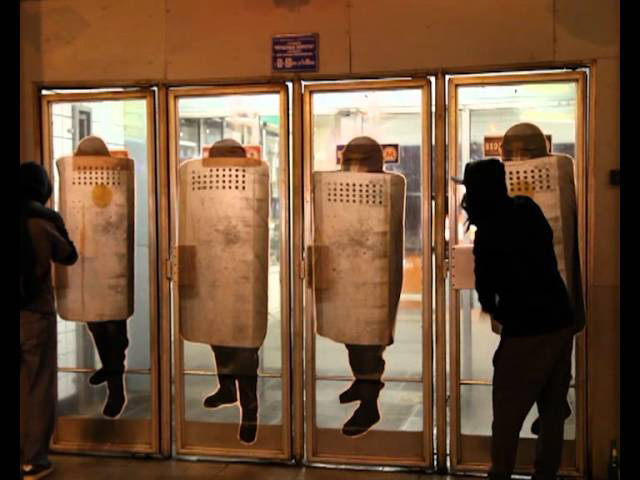
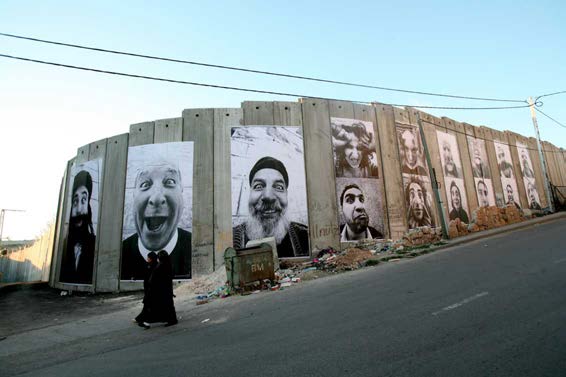
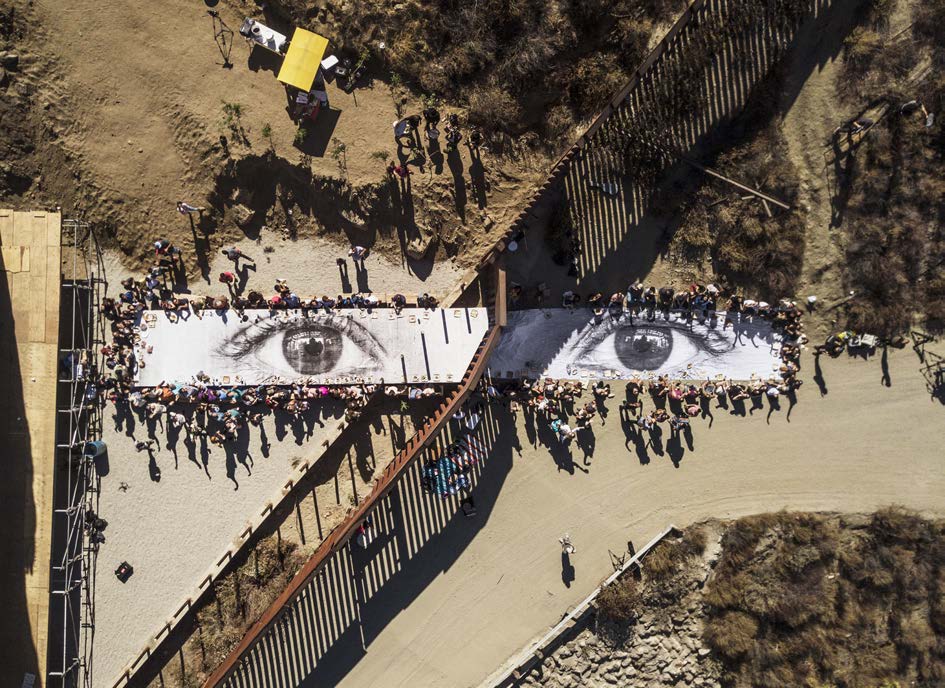
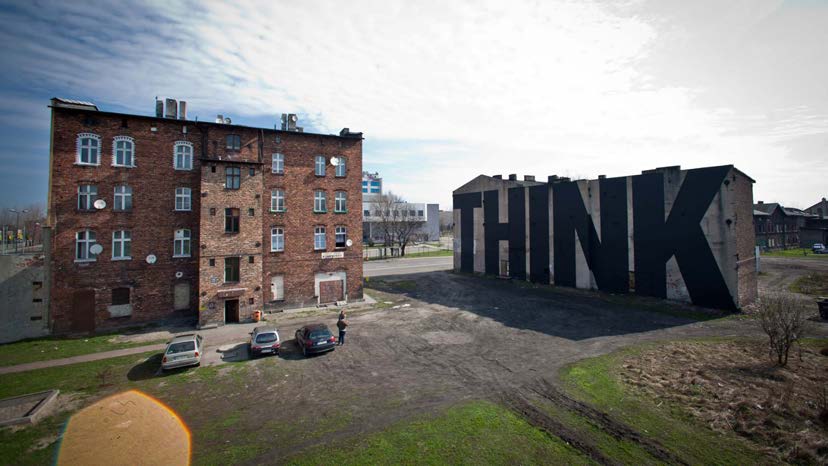
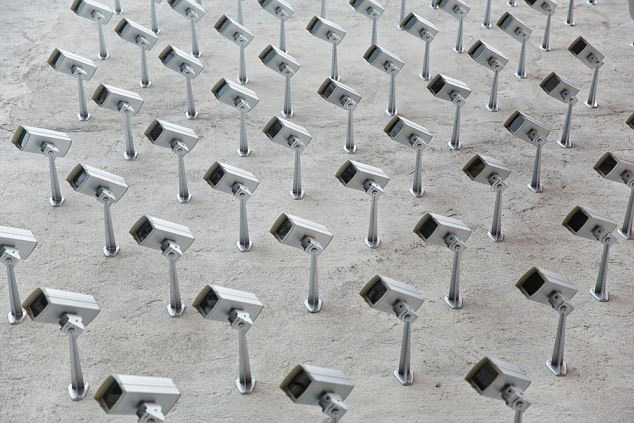
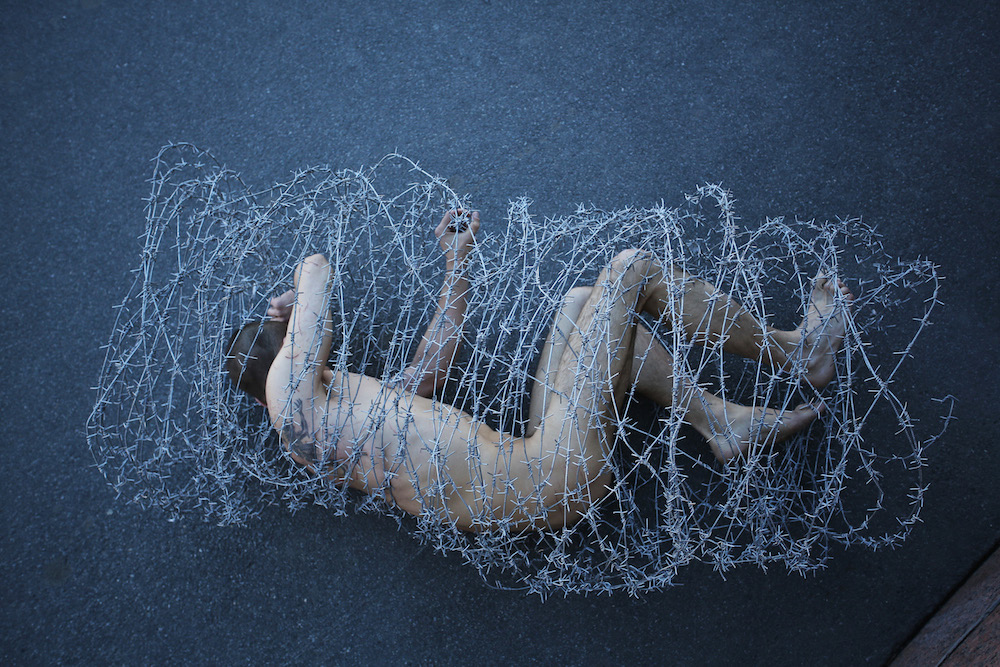
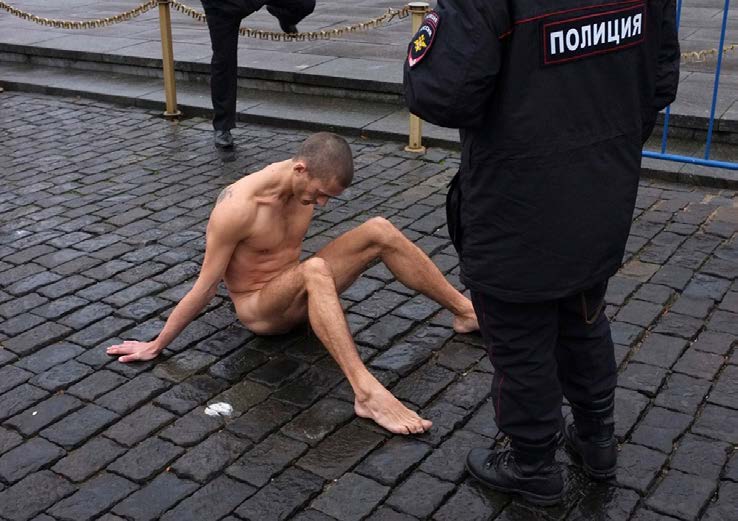
He explained the idea of his performance as follows: “If the country turns into a police state one day, it will be filled with spies, cops and security cameras. And one day the permanent Police Day will come. All that remains will be your desperation and your testicles nailed to the cobblestones.” Faced with the cops most of the time, the artist may not have helped change the regime in Russia, but the whole world learned about his performance and what he was criticizing.
Artivism, which started with graffiti and performance art, has been the means of expression of artists in all kinds of art methods and disciplines. Gianluca Costantini is also an Italian comics and cartoonist, who also introduces himself as a political activist, working on freedom of expression and human rights. Costantini was nominated for the European Citizenship Awards in 2017 and received Amnesty International’s Arts and Human Rights award in 2019. As an artivist, he uses his art to stand by the good and against the evil in the world. The artist has collaborated with Ai Weiwei, who is also a very sensational artist, and still does.
The artist, who supports the activists who have a case, who have been wronged or who want to have their voice heard, interpreted the Gezi Resistance period for Turkey in his own way and showed his support to the insurgents and imprisoned artists at every opportunity.
“Because if everything is art, everything is political. If you draw a flower pot, there is not only beauty in it, but you also prove that you are in this world and that you are thinking about this world. If you’ve been potting all your life, your thinking is probably that all is well, politics and war. But as an artist, you can help someone else change their position. I try to help people in danger as much as I can, to give artistic support, to produce material that will awaken the conscience, to spread the news, to witness what is happening.”
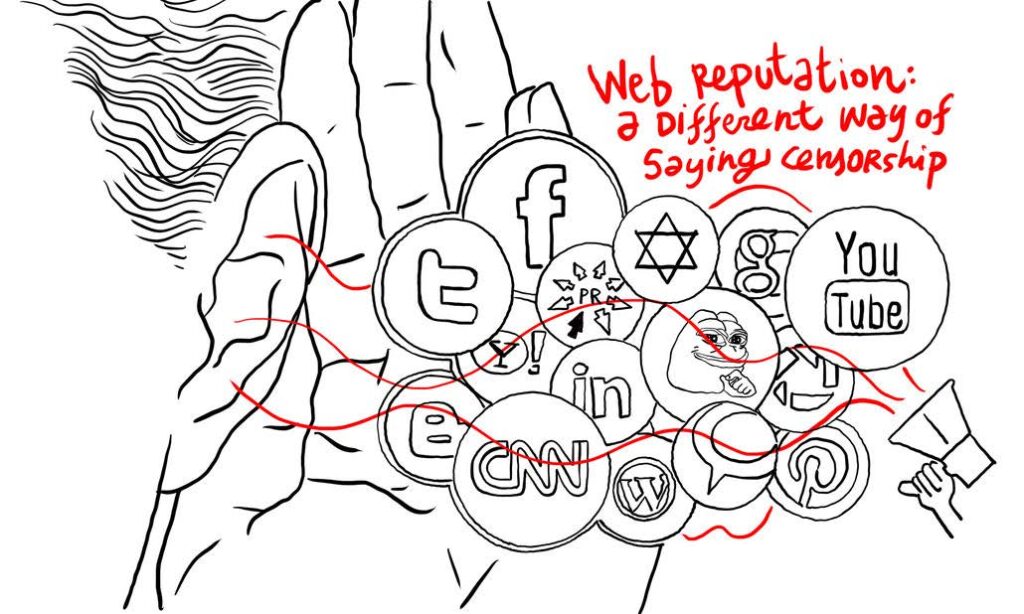
2019, Italy, Cartoon
Artivism, which started with graffiti and performance art, has been the means of expression of artists in all kinds of art methods and disciplines. Gianluca Costantini is also an Italian comics and cartoonist, who also introduces himself as a political activist, working on freedom of expression and human rights. Costantini was nominated for the European Citizenship Awards in 2017 and received Amnesty International’s Arts and Human Rights award in 2019. As an artivist, he uses his art to stand by the good and against the evil in the world. The artist has collaborated with Ai Weiwei, who is also a very sensational artist, and still does. The artist, who supports the activists who have a case, who have been wronged or who want to have their voice heard, interpreted the Gezi Resistance period for Turkey in his own way and showed his support to the insurgents and imprisoned artists at every opportunity.
“Because if everything is art, everything is political. If you draw a flower pot, there is not only beauty in it, but you also prove that you are in this world and that you are thinking about this world. If you’ve been potting all your life, your thinking is probably that all is well, politics and war. But as an artist, you can help someone else change their position. I try to help people in danger as much as I can, to give artistic support, to produce material that will awaken the conscience, to spread the news, to witness what is happening.”
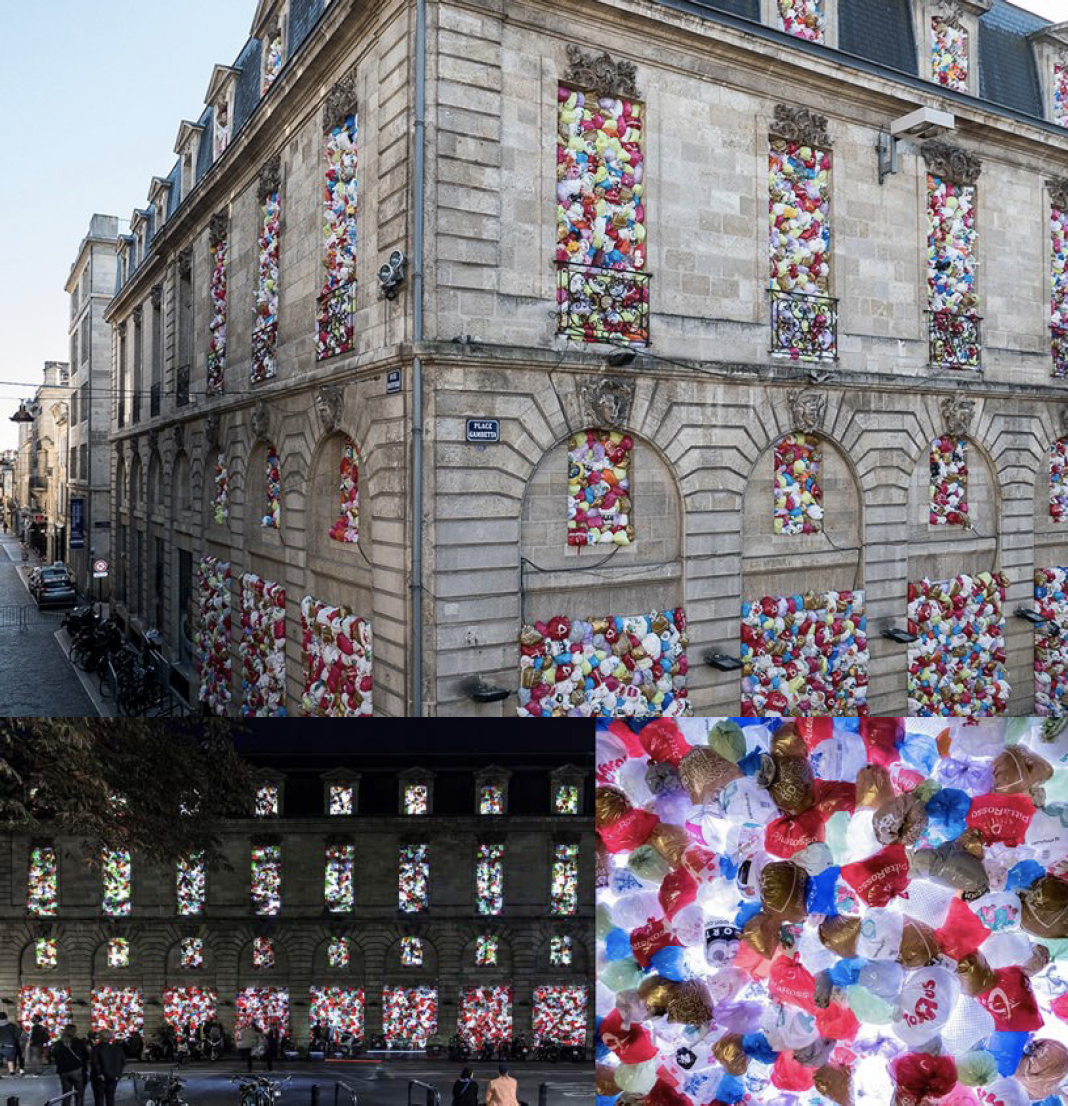
Day ( Up ) – Night ( Down-Left ) – Close View (Down-Right)
The Collective Power of Artivism
Artivism also contains many examples of collective works. One of the influential groups on collective work is Luzinterruptus. The Spanish group works on the environment and the use of plastics; They emphasize that recycling is not a healthy solution, and they argue that states should take a clearer stance on not using plastic. At the same time, they bring many social issues to their art, from defending the principles of freedom of expression and democracy, to the fight against consumerism and the protection of natural resources.
Luzintteruptus, which participated in the FAB Festival held in Bordeaux, France in 2017, chose Virgin Megastore, one of the biggest stores in the city, for the project, and filled all the gaps on the facades of the building with more than 6000 shopping bags belonging to the big brands they collected with a volunteer team. . The building looked like it was going to explode from plastic bags. At the end of the festival, all the bags were recycled and the building was left in its original state. With the lighting system they used, they managed to attract the attention of the audience throughout the day. For the project “The Plastic We Live With” (2017), the group aim to show the danger of the use of plastic by stating “This ubiquitous material not only creates huge plastic islets in the oceans, but tiny bits in the water we drink and the things we eat.”
An effective series of practice of action to collective work belongs to the Liberate Tate group. Years later, the group’s performances against the oil company Bp’s sponsorship of the Tate Museum achieved their goal, causing the company to withdraw its sponsorship. Although the company did not accept this, members of the artivist group state that the opposite is true. Liberate Tate is an important example of artivism that succeeds and inspires with the right moves and actions.
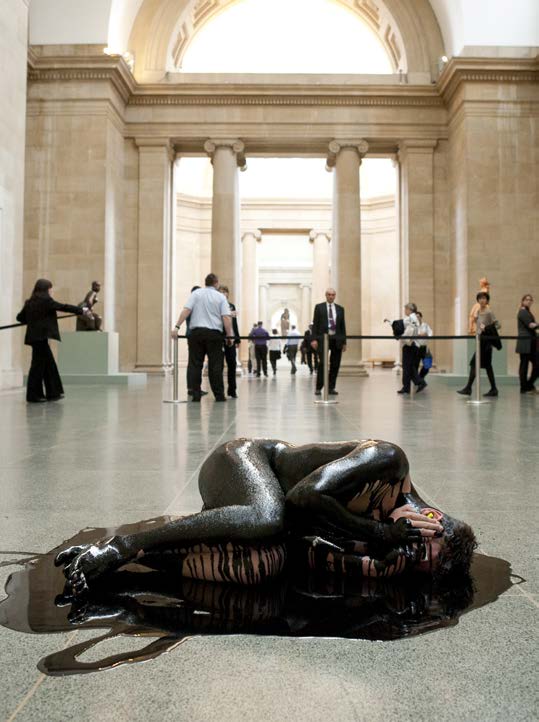
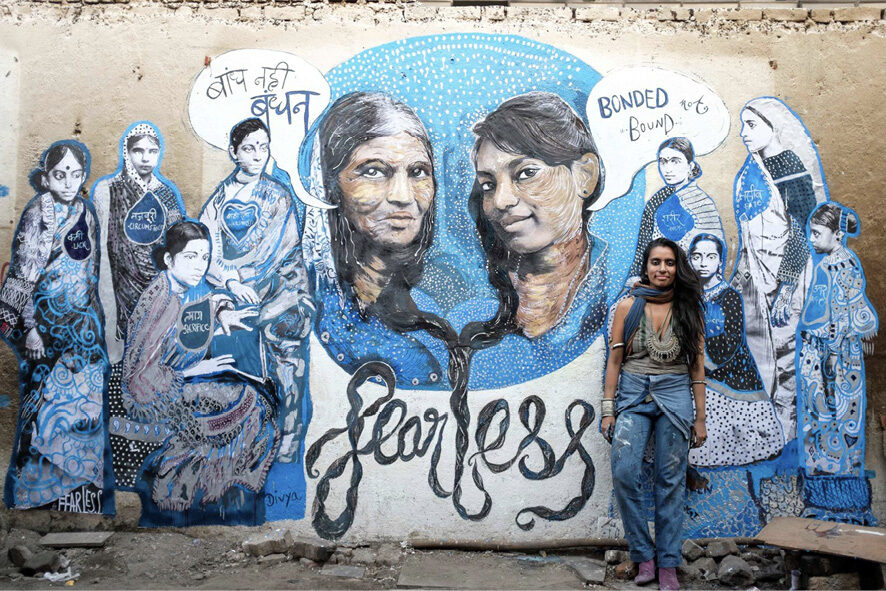
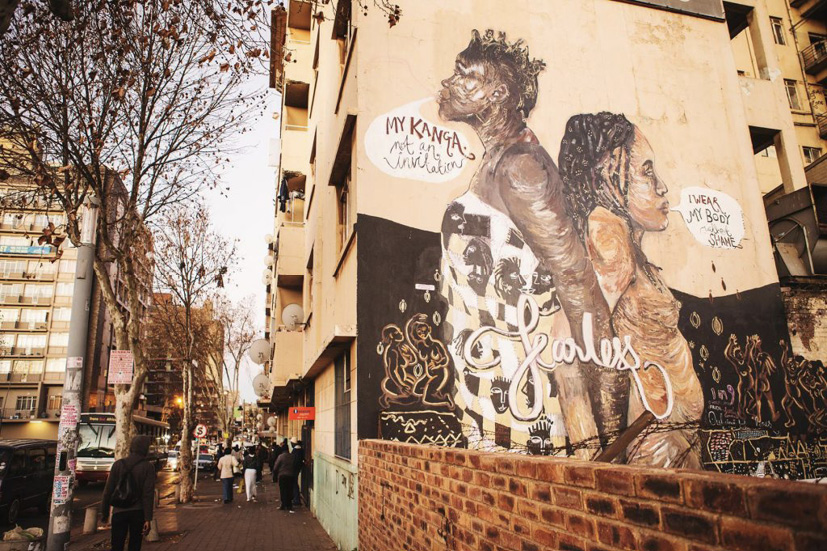
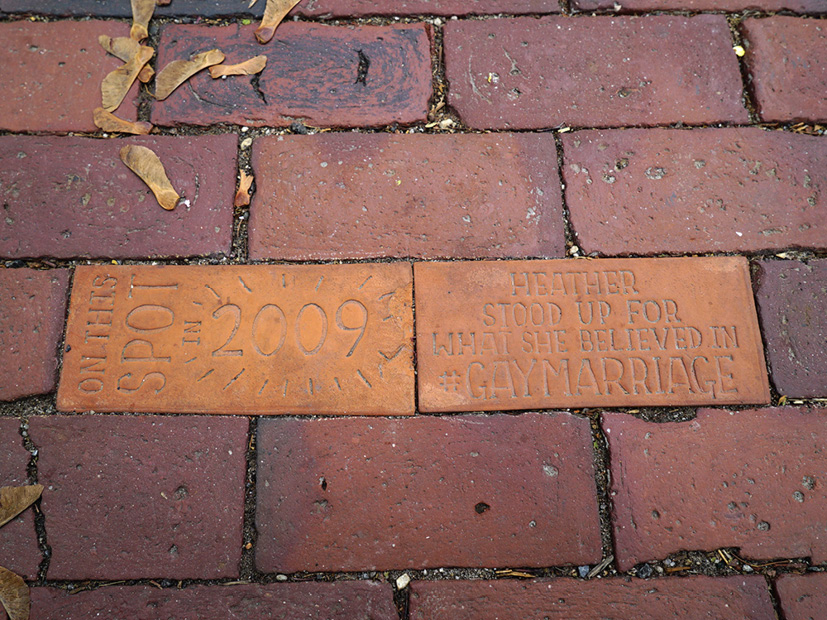
“Over the past six years, Liberate Tate members – along with other cultural activist organizations – have held a series of demonstrations and protests demanding the end of the sponsorship deal. Much of the action took place in the form of unauthorized performances at Tate Modern and Tate Britain, from the miniature oil spill at the institution’s summer premiere to the gifting of “License to Spill” 2010, a 16-metre wind turbine “The Gift” 2012 to the museum. and by establishing tattoo parlors inside the gallery, the carbon dioxide level of the atmosphere was tattooed for each artist in the year he was born “Birthmark” 2015.”
here are groups working on different social issues in different countries of the world, as seen in other examples, these groups have shown the power, speed and permanence of the collective work. Fearless Artivist group Fearless Collective was also founded in 2012 by Shilo Suleman, they aim to turn the world into a brave and beautiful place by leaving fear behind while telling cultural and political stories. In general, they use images specific to events by choosing places where trauma, oppression or fear occur, while applying mural works in their projects in public.
“Shortly after the gang rape and murder of 23-year-old Jyoti Singh Pandey in New Delhi in 2012, artist Shilo Shiv Suleman started this feminist movement and art collective Fearless Collective. … Since its inception, Fearless Collective has worked on projects in Pakistan, India, South Africa, Indonesia, Nepal, Lebanon, Brazil, the United States and Canada. The projects have worked in different communities, addressing issues such as gender-based violence, feminism, oppression of transgender communities and indigenous rights. ”
They performed the mural “Bonded Not Bound”, which the group made in Dharavi in 2015, together with local women. They also supported the participants by giving trainings in the workshop they held by coming together, communicating, and getting their opinions on the area they lived in. The main painter is the founder Shilo Suleman, and the blue of the blue tarpaulin, which symbolizes cheapness and poverty, is used as the main color and is positioned to have its own boundaries in this large slum. In the small but crowded neighborhood, women often stated that they needed a bond of love rather than the binding rules imposed on them.
They summarize their methods as follows: “We are returning to the old ways. We are witnessing space. We offer light and color and incense to forgotten corners. We fill the void with our bodies, stories and brushes.” In their paintings, they promise to keep the heroes of tragic stories alive, to ensure that the events that go unpunished are heard by everyone, to fearlessness and peace. In the mural in South Africa, they referred to the shame of a woman who was said to have been raped because of the clothes she wore.
While the Fearless Collective group actively uses social media to promote collective work, it also continues to cooperate with countries and individuals who want to make their voices heard or collaborate. The group, which also supports workshops, provides virtual training in this sense.
21st century The changing perspective in societies from the very beginning has been especially effective in the upbringing of young people. Young people born into the digital age display a libertarian, right-seeking attitude that is against all forms of discrimination. In this context, activism has inevitably been a part of their lives. Although there were short-term experiments on activism education in the 1950s, artivism is also included in art education as it is in activism today. Many educators continue to teach in schools with their activist identity, after the times when an activist educator had difficulties between his career and his art. In this sense, artivism prepares individuals for the real world, and enables productive artists to grow at the point where participation, collective work and awakening meet. Unlike traditional art education, the process, participation and ideas are at the forefront of understanding.
“Culture is an important food for human socialization. However, the individual gets rid of competitive, passive commodified views of life and adopts a fun, hedonistic, sharing or generous vision. Artivism is a social ethical literacy that leads to one’s “non-individualistic autonomy”. […] In the end, artivism guarantees the integration of the individual in the construction of collective spaces and contexts, of every person with creativity, both individual and diverse.”
In short, one of the most important contributions of artivism in education turns from the individuality of the artist or student to sharing, interactive group work, which means a creative and intense process. Since mutual interaction, different interests and perspectives are at the forefront, collaborative creation, where the ego is put aside, ensures that individuals are open to new understandings.
Plastic Arts and Artivism
The dissemination of the works done to a wider audience, the opportunity for rich creativity in the intellectual dimension, as well as the power of being together are also important. Ayumi Horie is an artivist who works on ceramics with social content. She sincerely conveys the subjects that individuals want to draw attention to with objects they can connect with. The artist, who uses video, installation and social media as well as ceramics, gives priority to collective works.
“Portland Brick” is a collaborative project with Elise Pepple, which brought the stories compiled from the events that took place in Portland’s India Street to the streets by processing them into bricks. In this way, it was ensured that everyone who passed by that street learned the stories that happened there. They summarized the main idea of the study by saying, “By stratifying the past, present and future, we hope residents and visitors will better understand what makes this neighborhood special”.“Heather Stood Up, 2009”,Heather Tanguay stood up and said that gay marriage is a right in 2009, when she stood up and said that same-sex marriage is a right. has seen. That’s why this inspiring tale of courage is the subject of the Portland brick.
“The Democratic Cup” is a collective project that he realized with Nick Moen in 2016. Within the scope of the project, illustrators and ceramic artists aimed to draw attention to the danger of political polarization, to respect political discourses and to encourage them to vote. At the same time, they sold the mugs they made as a donation campaign and distributed them to non-profit organizations. The artivist ceramic artist Robetro Lugo, whom we discussed before, also worked on the mug with Kristen Kieffer, the portrait of black women’s rights activist Sojourner Truth, in this project.
Thinking that the conversations that start with a cup of coffee and the ideas to be shared through mutual dialogue will be more profound and meaningful, Horie stated that they believe in the power of sharing only, without religion, language, race or nationalist approaches, or even wrongly, in collective work. In an interview, Horie said, “Putting ourselves in someone else’s shoes is one of our goals in this project, to sit down sincerely and listen to what our coffee partner has to say. It’s not just about discussing our own issue; It’s about really trying to understand where someone else is coming from.” he literally expressed the purpose of the project.
Approximately 50 artists from different disciplines, including illustrators, ceramic artists, writers, graphic artists, painters, and architects, worked on the project. In the handmade designs, many topics are mentioned, from LGBT rights to Ruth Bader Ginsburg and immigration. In the project, mugs designed by writers Danez Smith, Klai Brown and Nick Moen are “What Did I Do?” he asked the question. Nick Moen, the partner of the project, drew attention to the lack of empathy in American politics and stated that they aimed to encourage constructive discourse with this project.
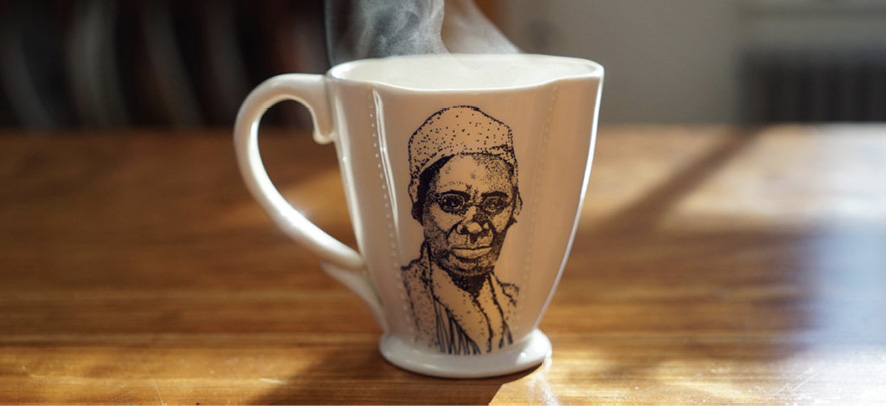

“The Democratic Cup” organization stated that they would continue their work with different projects as of 2021, and they decided to retire the group in a democratic way after one of the artists left. Ayumi Horie continues to make useful art for different collective works. Horie states that today’s art will cause rapid change when it is shaped in the right hands and with accompanying stories. Knowing that every person’s time in the kitchen is precious, she gives the message of strengthening the bond between functional objects and individuals and standing strong against inequalities.
If the aim of artivism is to influence societies and to work on the permanence of its effect, to put it correctly, the fragility of ceramics has been an important tool in terms of impact. Ai Weiwei is the most famous ceramic artist known for his activist attitude. The artist, who argues that art is political, displays an attitude that reacts to injustice, resists the oppressive regime and has a stance. He expressed his message as follows: “fighting for individual freedom, fighting for democracy, and while doing so, clearly informing the public and being someone who has an influence on others.” When the artist, who was in America in the 80s, returned to his country after a long time, He saw that there were changes in social and economic sense.
Reflecting this change to his art with a critical perspective, Weiwei started to make series that bring modern criticism with his traditional art, ceramics. The artist’s first work as an activist was the performance “Dropping a Han Dynasty Urn” in 1995. Weiwei made the antique vases he collects a part of modern art, but he was criticized for breaking the vase while doing so; breaking the precious vase has been interpreted as disrespect to cultural heritage. However, the aim of the artist was to remind the evils of the Mao regime and openly criticize the hypocrisy of the communist regime and the fact that they later protected the historical artifacts that they destroyed in the name of the cultural revolution. In this sense, Weiwei’s action was precisely to follow General Mao’s advice to destroy the old for the new world.
Coming from an aristocratic family, ceramic artist and activist Carrie Reichardt brings her ceramics to the streets and aims to reach a wider audience. She made her first solo exhibition with the title “Mad in England”, with works reflecting her political statements. The artist, who works with the mosaic technique on the facades of the buildings, also uses collages consisting of photographic prints.
In 2014, she made two-piece, fun, provocative and sincere mosaic collages for the Victoria and Albert Museum entrance. His aim was to show that the combination of art with activism would lead to positive social change. The project, which he named “Disobedient Objects”, touched on many social and political problems of the society and the world, and became a very popular exhibition that reached approximately 400,000 people. On the stairs at the entrance of the building, he used peaceful phrases that support his view and make the audience think.Reichardt stated that art becomes more meaningful when it focuses on making a difference, and that activism is a lifestyle at the same time, and describes himself as a craftsman by being included in the Craftivism movement.
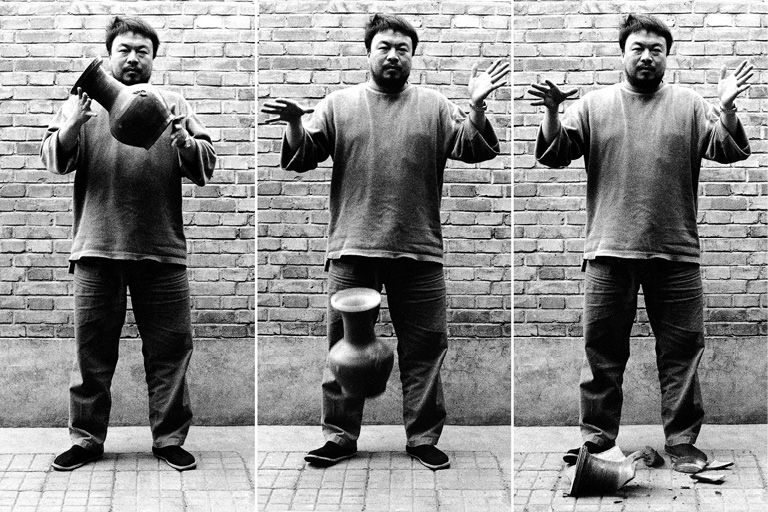
While dealing with subjects such as unjust imprisonment and colonial wars, the artist states that the death penalty is polemic and intimidation, and aims to influence the audience both intellectually and emotionally.He reacted by writing “You Can Kill a Revolutionary but You Can’t Kill The Revolution” on the wall panel about the murder of an activist Fred Hampton by state power.
We have discussed in the previous sections how important street art and graffiti are for art to reach the society. The presence of ceramic art on the streets is not so new, but the ceramic relief, which is included in the street art today, reaches the audience in a surprising and remarkable way, rather than being a protective material. There are examples of street culture, in which artists sometimes approach a city like a game or draw attention to the problems of the world, or that surprise the audience and make them think. In addition, as in the example of Carrie Reichardt, the collaboration of mosaic and graffiti, which is a classical technique, ensures the permanence of the message, which is a valuable opportunity for an artivist artist.
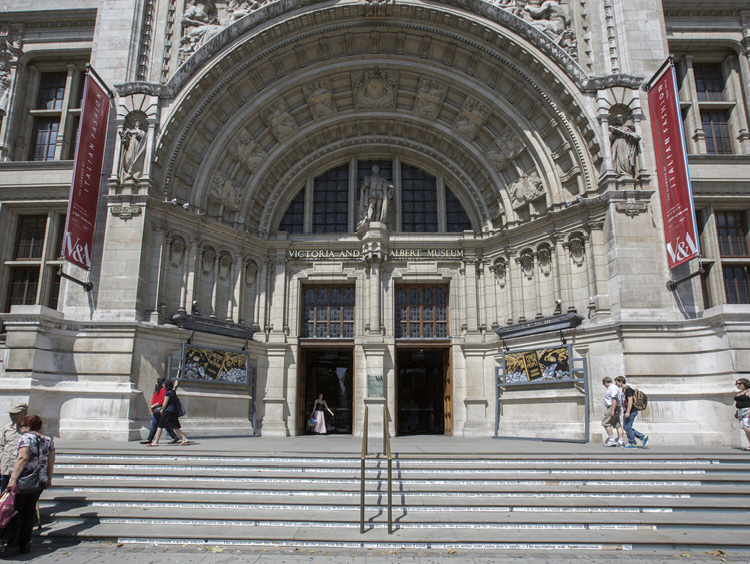
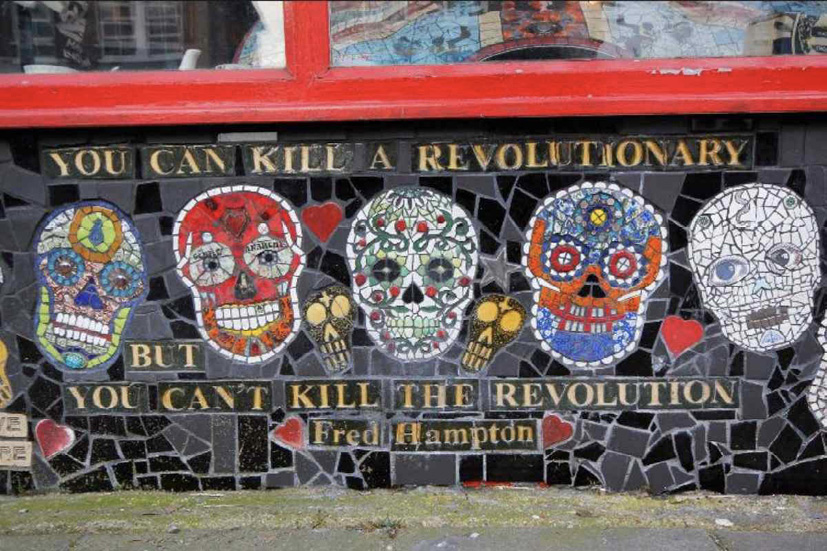
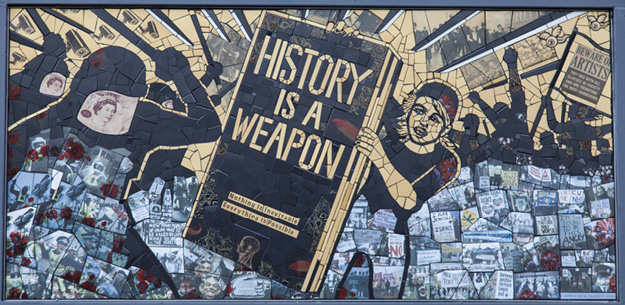
The “Scrabble” project, which he made at the Art Boom Festival in 2011, laid the words on the walls in the form of a Scrabble game with the mosaic technique, which touched on the problems of the world and aimed to make the audience think about these concerns. “The Scrabble project reflects the mosaic of information we use to create our image of reality. […] GMOs, global health policies, the nature and causes of financial crises, corporate social responsibility, global warming, conspiracy theories, etc. The artist, who also published these installations as a documentary series on YouTube, shared both the traditional ceramic process and the images he mounted in Krakow, Poland. In the image, he wrote words such as “Drought, Resources, Thirst, Misery”, which will evoke thirst and its results, under the title “Dirty World”, which draws attention to global warming.
Jennifer Ling Datchuk is a ceramic artist and educator working on cultural conflicts, identity and immigration as the child of a Chinese immigrant and the granddaughter of Russian and Irish immigrants. Using different materials, the artist named “Live to Die” criticized the devaluation of the labor of young people and children working cheaply in China in the face of the capitalist order. He used the red mat, which is often used on the doors of Chinese restaurants in the USA, as a metaphor, and smashed young girl figures are seen among a pile of mats that overlap. He draws attention to the tiring conditions of these young people, who are mostly invisible, but that they are invisible in the cycle of consumption and satisfaction.
Another artist who criticizes the overpopulation in China, employing cheap workers and the invisibility of the working people is Ai Weiwei. In addition to being an important conceptual artist, his activism has made art a part of his life, and he argues that the artist should set an example for the society. He states that his life, stance and style are his own art and that he made a political decision by choosing art. Working in different materials and disciplines, the artist chooses his material according to the most accurate expression method. Since the 90s, he has exhibited an attitude of criticism of the system in his art, and in this sense, he has often been tried, detained or arrested. Weiwei, in his performance of knocking down the Han Dynasty Vase, which we discussed before, criticizes the governments and the oppressive regime, and again, by embroidering the Coca Cola logo on an antique Han vase, he challenged the consumption system where a brand even surpasses the real values.
“Sunflower Seeds” (2010), like Jennifer Ling Datchuk, drew attention to the large population in China, the cheap production, and the ignorance of the worker. Although the installation, in which approximately 100 million moon seeds are exhibited, is thought to consist of real moon seeds, it is entirely porcelain. The moon cores, made by 1600 talented craftsmen, are an artivist work that has a lot of meaning. First of all, the artist stated that sunflower seeds represent poverty and unifying power in Chinese culture. Because it was cheap, it became a chat accompaniment shared by friends.
During the Cultural Revolution, General Mao was depicted as a sun and the people as sunflowers turning towards him. It expresses the contradictory feelings that include friendship and poverty in this cruel period. The sunflower seeds, shaped by 1600 people one by one, bring to mind the phrase “Made in China” and show the impressive results of acting together as a result of a collective work. Encouraging his people to reform, the artist for “Sunflower Seeds” says “Seeds grow… The crowd will eventually find its way.”
Conclusion
The concept of artivism, as stated at the beginning of the article, refers to art made for the benefit of society with empathy inspired by activism. For centuries, the artist’s path has crossed with politics, sometimes he has been pro-power and sometimes he has been a power that stands against power.
Since the effect of art on societies is known, it has been an important tool used by the authority. However, as the means and methods of expression have changed over time, there have also been changes in the artist’s attitude and style. These changes provided the birth of art movements.
Today, there are still influential art movements, the methods have been enriched with the development of technology, but the traces of inspiring movements are still visible. As societies developed socio-culturally, artists did not remain indifferent to issues that were approached sensitively and voiced.
Men and women, children, animal rights, climate, global warming, class discrimination or racism are the subjects that are mostly discussed in art. Artivist artists try to spread their messages both in exhibition halls and on the street and to raise awareness of the society. The examples in which collective work is more effective are inspiring, at the same time, making artivism a part of education is an important step in terms of artist and society standing side by side and making the world a better place.
Ai Weiwei’s individual works continue to produce by standing up against all kinds of injustice as a world citizen, even though his criticisms lead him to jail. It is promising for the future that the victory of Libarete Tate over the oil company BP or the paintings of Fearless Collective about women’s rights raise awareness of local people and fight for women’s rights. As a result of the protest actions of Pakistani women as of 2020, the removal of virginity tests of rape victims is an important success, and the fact that women’s painful stories have been brought to the walls can be considered as the first step to raise awareness.
*Favela: It is the term used to describe slums in Brazil.
**FAB:Festival International des Arts Bordoeaux Métropole
*** *Mural: It comes from the Latin word “murus” and means “wall”. While graffiti is legally practiced with spray paints, Mural acrylic refers to paintings made on a certain area in a certain period of time using oil paint.
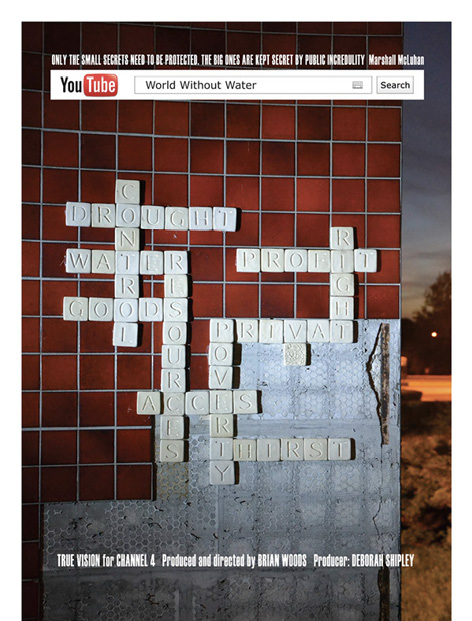
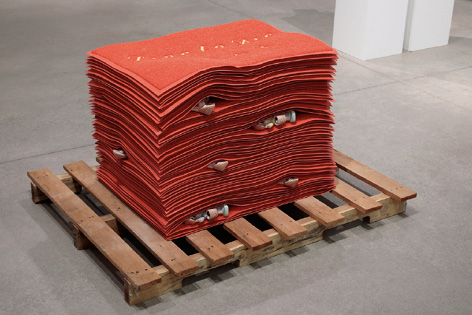
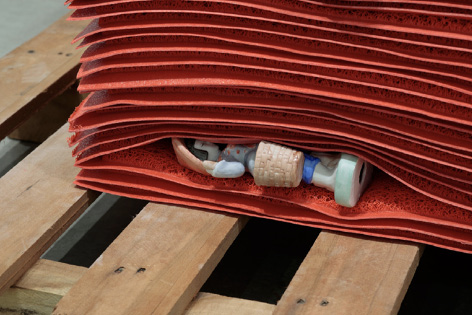
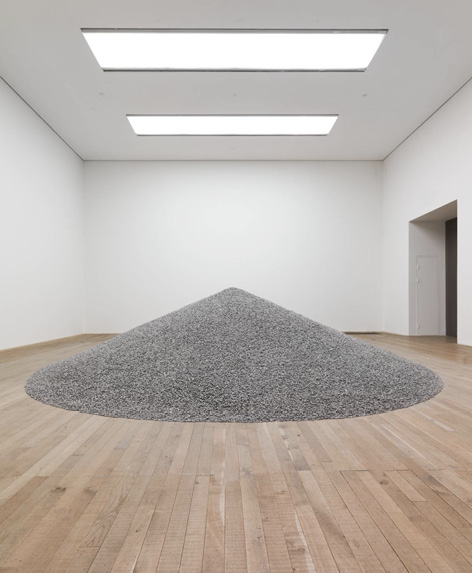
References
https://klebesadel.wordpress.com/2011/05/02/activist-art-art-that-works/ Access Date: 03.10.2020
KURYEL Aylin, ÖZDEN Fırat Begüm, “Küresel Ayaklanmalar Çağında Direniş ve Estetik”, İletişim Y., 23
https://www.jr-art.net/projects/migrants-picnic-across-the-border
http://spy-urbanart.com/about/ Access Date: 15.10.2020
https://www.dazeddigital.com/artsandculture/article/17937/1/meet-the-artist-who-nailed-his-testicles-to-the-red-square Access Date: 21.10.2020
https://m.bianet.org/bianet/sanat/206010-italyali-cizer-bir-ulkeyi-severseniz-orada-ozgurluk-mucadelesi-verenleri-de-seversiniz Access Date :20.10.2020
https://hyperallergic.com/288254/liberate-tate-activists-look-back-on-six-years-of-fighting-bp-sponsorship/ Access Date: 01.11.2020
https://wpmu.mah.se/nmict192group3/2019/10/23/activism-through-street-art-with-the-fearless-collective/ Access Date: 01.11.2020
https://fearlesscollective.org/fearless-methodology/ Access Date: 09.11.2020
https://www.researchgate.net/publication/326312718_Artivism_A_new_educative_language_for_transformative_social_action Access Date: 14.12.2020
https://www.publicartportland.org/project/portland-brick/ Access Date: 02.03.2021
https://springboardexchange.org/the-democratic-cup-wants-to-bring-people-together-in-conversation-over-a-cup-of-coffee/ Access Date:02.03.2021
https://www.opendemocracy.net/en/artists-duty-interview-with-ai-weiwei/ Access Date: 03.01.2021
https://www.behance.net/gallery/1618129/Scrabble Access Date: 03.03.2021
https://www.opendemocracy.net/en/artists-duty-interview-with-ai-weiwei/ Access Date: 03.01.2021
